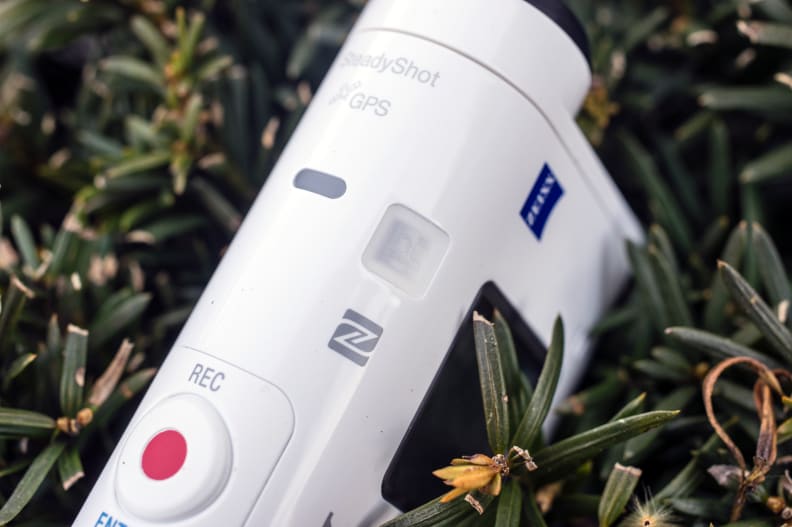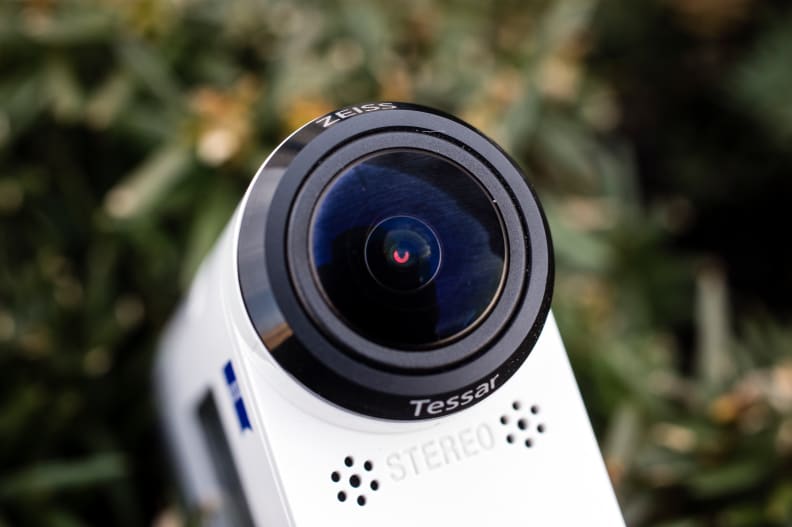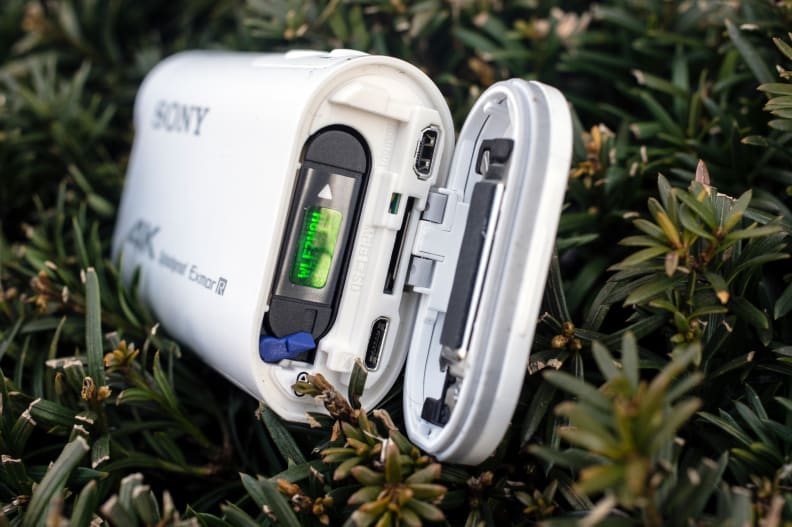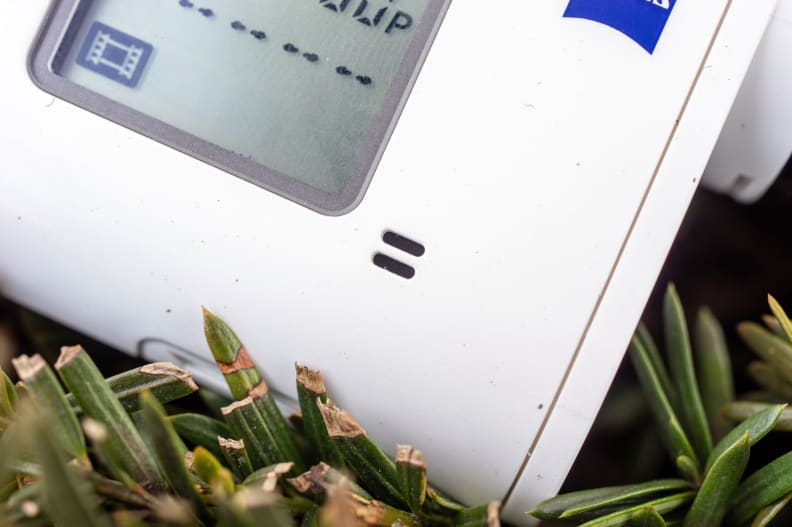Sony's most recent action cam, the FDR-X1000V (MSRP $499.99), is certain to have GoPro looking over its shoulder as it–like the GoPro Hero 4 Black Edition–shoots true 4K video at 30 fps. The X1000V has a few other features that set it apart from the pack such as a Zeiss branded lens, outstanding audio quality, Sony's SteadyShot stabilization, and a splash-proof body. For an additional $100 you can also pick it up with a live-view, wrist-worn remote that allows you to see what you're recording and control multiple cameras.
On paper, this not only looks like a giant leap for Sony, but for all companies that haven't been able to close the gap on GoPro in recent years. It could essentially show that GoPro can be competed with and in a sense, open the floodgates for for more competition. But unfortunately, this Sony's bark is bigger than its bite.
Design & Usability
When it comes to design, Sony didn't depart from the layout it's used with its previous action cams. The body is rounded with very few edges with a flat bottom–allowing it to stand on its own. The lens is extended in the front with tripod mounts on the bottom and battery bay on the rear. If I had to describe it to someone, I'd say it looks a lot like a miniature hunting rangefinder.
{{ photo_gallery name="Tour" }}
Since the last time we used a Sony Action Cam, we were hoping to see changes to the waterproof casing that comes with the X1000V. Even though Sony improved how deep you can dive with it–up from 16 feet to 32 feet–the GoPro case can still dive 99 feet deeper. Additionally, the Sony's rounded, plastic lens cover tends to attract water droplets instead of shedding them like the flat, glass GoPro cover. Not to mention it has a much bulkier mass than the new slim GoPro cases.
This lead to a debate around the office about whether the X1000V was more versatile for mounting than the GoPro cameras. In the end, we came to the conclusion that there are very few spots where the X1000V would be better or even as good for mounting in tight spots. The only time it would be obviously better is when mounting in a narrow spot because it is thinner than the GoPro from the front.
The controls are two buttons with an LCD on the side and a dedicated record button on the top. The two side buttons control the menus and can be slow and frustrating to use, but they get the job done. The downside with this style of control is there are many sub-menus, making it time consuming to change any settings. For example, turning on/off the WiFi requires at least 12 button presses while navigating 3 submenus. This gets old–quick. Compare that to the GoPro, which has one less button, but is much easier to operate. It can only be remedied by connecting it to another device via WiFi, like a smartphone or Sony's live-view remote.
That said, picking up the live-view remote package for the extra $100 isn't a very good fix for the clunky menus. First off, the live-view remote has the same number of buttons, requiring the exact same amount of time to change any setting. Secondly, it's going to drain the camera's battery at an exponential rate because it's constantly streaming via WiFi. I would recommend saving the $100 and connecting to your smartphone using the PlayMemories app. This will still drain the battery due to WiFi usage, but you'll get better controls than the live-view remote.

The X1000V has both IR and NFC to connect to devices for easy shooting and sharing.
The app also has a much more stable connection. I found the live-view remote disconnected very easily and the video lagged a lot. The app has much easier controls, letting you change settings with minimal time. That's not to mention, that your phone should have a far better screen, pulling out detail you'd miss with the remote. I would only recommend it in extreme conditions where you wouldn't want to put your smartphone at risk.
Performance
The Sony X1000V is by far Sony's best attempt at an action cam. Shooting 4K at 30 frame per second gives users an extremely sharp image–slightly sharper than GoPro's flagship 4K action cam. It also offers all the popular resolutions such as 1080/120p and 720/240p. All of this is driven on a 1/2.3" CMOS sensor that can also produce 8.8 MP stills with burst and interval modes.
A big performance plus on the X1000V is the ability to record 4K at a whopping 100 Mb/s which improves image motion and overall quality. This is achieved through XAVC S recording, but requires a new microSDXC card with a UHS-I U3 rating. These are available for around $60, but won't be easy to find at local stores for a while–eliminating the ease of simply grabbing an extra card or two while on the go.
The result of that extra resolution is noticeable if you're viewing content at full resolution. We observed a resolution up to 1,250 line pairs per picture height. This is about 25% more than the GoPro Hero 4 Black and double what we saw with the best HD action cameras on the market. When we dropped down to the 1080/120p setting, we saw silky smooth video that provided excellent 4X slow-motion when played at 30 fps. Even with the drop in quality, this resolution was preferred for capturing fast moving subjects.

The Zeiss branded lens is a 17.1mm (35mm equivalent) f/2.8.
Action cams generally struggle in low light because the sensors simply aren't big enough, and bigger sensors mean bigger–and less portable–cameras. Because of this, like most action cams, the X1000V is not the best performer in low light settings, though it did hold its own when compared to GoPro. We were able to get usable images in similar conditions as the GoPro Hero 4 Black, but if you're looking to shoot dark locations I recommend bringing a few external lights.
Another important area for action cams is battery life and, unfortunately, small cameras also mean small batteries. When shooting 1080p with the X1000V, we only get around 63 minutes of continuous shooting. This is a frustrating result seeing how you can't add extra battery time to the X1000V with a battery pack like you can on GoPro cameras. Even without a battery pack, the new generation of GoPros all saw 100+ minutes of 1080p shooting.

The battery, memory card, and charging port are all located in the rear of the camera, sealed in an airtight bay.
The shooting time also drops pretty dramatically if you introduce any features like WiFi, GPS, or 4K. This is most unfortunate since you have to use WiFi to connect to a smart device in order to circumvent the terrible menus or to see what you're shooting. And without a battery pack, you're stuck stocking up on batteries for the X1000V before heading out for a full day of shooting.
Features
The X1000V has a handful of features that give it an edge over most action cams on the market, particularly the 4K 30p shooting, which is only matched by GoPro's Hero 4 Black Edition. In addition to the 4K shooting, it is splash-resistant with an IPX4 rating right out of the box, no case needed. This is helpful if you're filming in an environment where a bulky case isn't needed, but the camera could still get wet. Not using the case allows for better audio and better image quality since you don't have to worry about an additional element for the lens to shoot through.
{{ photo_gallery name="Design" }}
When using the case, the X1000V is waterproof, dustproof, and shockproof, like most action cams. However, like other Sony action cams we've reviewed, it's only waterproof in relatively shallow water–32 feet to be exact. This is pretty weak when compared to the GoPro which can plunge over four times as deep–up to the deepest depths allowed to most recreational divers.
The X1000V has a decent range of resolutions to shoot in, ranging from 4K at 30 fps to 720p at 240 fps. In total the X1000V has 12 resolutions options–as compared to 49 on the new GoPro Black. Many of the GoPro modes are things like 2.7K, 4:3 ratio, and its SuperView mode. These are less commonly used, but it's always nice to have more options.
One feature that really boosts the quality of your footage is the option to record in XAVC S. In order to record in 4K you have to use the XAVC S which outputs at a resolution of 3,840x2,160. The frame rates available are 30/24p at 100 Mb/s or 24p at 60 Mb/s. XAVC S also offers 100 Mb/s or 60 Mb/s bitrates for 1080/60p or 720/240p and 50 Mb/s for 1080/60/30/24p. To access the 100 Mb/s speeds, you need a microSDXC card with a UHS-I U3 rating or else the camera will flash the word "Media" and won't let you record until you change to a lower bitrate. If you choose to record in MP4 your options are 1080/60/30p, 720/120/30p, or 480/240p.
One thing Sony really pushes on its cameras is the SteadyShot image stabilization, which in theory this gives it a let up over GoPro–since GoPro doesn't offer any stabilization. However, the stabilization is digital (not optical) and simply crops the image a bit to level out the image while taking away quality in the process. In previous Sony action cams, we've hardly noticed a difference and nothing has changed with the X1000V. Additionally, SteadyShot isn't an option for the top modes such as 4K/30p, 1080/120p, and 720/240p, limiting it to modes that are less desirable anyway.

The speaker located on the side plays audio for the menus only.
Finally the X1000V does offer built-in GPS, WiFi, NFC, and the ability to live stream footage to Ustream. The GPS, WiFi, and NFC have obvious advantages, letting you to connect to other devices, geotag, and share video quickly. What might be new for users is the ability to live stream footage as it is happening. All you need is a Ustream account to log into and you're ready to share your footage live with the entire world–at least until the battery craps out.
Conclusion
At the end of the day, in the action cam market, the buck stops at GoPro. Whether a company is trying to compete with them or not, they are the standard that everyone is held to. In order for Sony–or any company–to steal a substantial piece of the action cam pie, it has to make a flagship camera that's better than GoPro's.
Sony did succeed in providing the X1000V with slightly sharper 4K video than the GoPro. But it doesn't make up for the atrocious menus, clunky controls, relatively shallow diving depth, and lackluster ecosystem of accessories. It's just hard to recommend it when the Hero 4 Black costs the same amount of money.
Sony at least understands that the action cam game is as much about marketing as it is about making great cameras. That's why it has enlisted champion skateboarder and extreme sports icon, Tony Hawk as the face of the new action cam. Tony will probably be able to push into the extreme sports culture that GoPro has made with such names as Shaun White, Alana Blanchard, and Lindsey Vonn.
Even when we just look at the hardware, Sony's 4K Action Cam–while greatly improved–still can't compete with GoPro's flagship camera. The Hero 4 Black simply offers more control and a wider range of accessories, not to mention cool extras like Protune and SuperView.
This is by no means a knock on Sony. It's clearly moving in the right direction, and this is a company that makes some of the best camcorders around. GoPro should be worried since Sony will likely continue to close the gap even more with future action cams. The X1000V just isn't quite there yet.
By the Numbers
Sony has come a long way since it first got in the action cam market a few years ago. During that time it has quickly become the number two action cam company behind GoPro, but the gap is still pretty significant. The new FDR-X1000V has gone a long way in closing that gap with 4K video that rivals GoPro's quality.
4K resolution, 100 Mb/s bitrates, and decent low light performance is giving us a lot to be excited about for Sony action cams. Here's a full rundown on what we observed from the X1000V in our labs.
Sharpness Performance
Sharpness is by far the brightest light shining on the X1000V. 4K obviously brings a giant leap over 1080p in quality, but Sony has taken it a step further by implementing the highest bitrate that we've seen on an action cam–a whopping 100 Mb/s. This is the best way to improve quality on action cams since you can't increase sensor size–due to wanting to keep camera size down–because it improves the write speed, which makes the video smoother.
This is fairly impressive considering GoPro tops out at 60 Mb/s when shooting 4K footage. However, it does come with the downside of having to use an expensive micro SD card that is rated for 95 Mb/s write speeds. These aren't readily available in most stores yet, so it could take a few days if you need a new card.
That said it pays off as we observed a staggering 1250 lp/ph (line pairs per picture height) both horizontally and vertically while shooting 4K. This is about 25% more that what the GoPro Hero 4 Black gave us (1000 lp/ph) and about 80% more than most HD cameras (around 700-800 lp/ph).
Below is a sample of the 4K video.
Low Light Performance
Low light performance is a bit tricky for all small sensor cameras and action cams are no different. Sensors simply aren't big enough or able to collect as much light thus creating darker images when light is sparse. The best performance we've seen out of an action cam in this category was 3 lux with the GoPro Hero 3+ Black last year, with GoPro sliding backwards in this category on the Hero 4 Black.
The X1000V was able to produce a usably bright image with a light level as low as 5 lux. This is the exact same point that the GoPro Hero 4 Black was able to reach meaning that Sony hasn't discovered a way around small sensor low light limitations either. That said, the image at 5 lux is far from something you'd want to use except in an emergency situation. If you're looking to shoot in relatively dark environments, be prepared to artificially light the scene.
Motion & Detail
Sony covers all the major resolutions 4K/30p, 1080/120p, and 720/240p. While 4K is obviously the sharpest, 1080/120p is the most balanced between quality and detail. Couple that with the fact that most people still don't have access to 4K monitors, the 1080/120p is your best bet for most situations.
The higher framerates allow for a lot of leeway when editing as well. Slowing down the 1080/120p four times gives silky smooth slow motion at 30 fps. This becomes even more fun if you shoot 720/240p and slow it down eight times, but you start to really sacrifice the quality at that point.
I'm not entirely sure why someone would drop down to the 480/240p instead of the 720/240p, but below is a sample of what it looks like at 480p.
Battery Life
Battery life is a spot that Sony needs to make progress. GoPros are notorious for having short battery life, but compared to this Sony they are a godsend. The X1000V only managed to get 63 minutes of footage in 1080/120p before having to recharge. This is without WiFi, GPS, or any other battery draining features we could think of.
If you're planning on going out for a few hours of shooting, make sure you pack plenty of these guys.
Meet the tester
As a photojournalist, Jackson has had stints working with bands, the military, and professional baseball teams before landing with Reviewed.com's camera team. Outside of Reviewed.com, he can be found looking for the next game to relieve his "Gamer ADD" or growing his beard.
Checking our work.
Our team is here for one purpose: to help you buy the best stuff and love what you own. Our writers, editors, and lab technicians obsess over the products we cover to make sure you're confident and satisfied. Have a different opinion about something we recommend? Email us and we'll compare notes.
Shoot us an email




